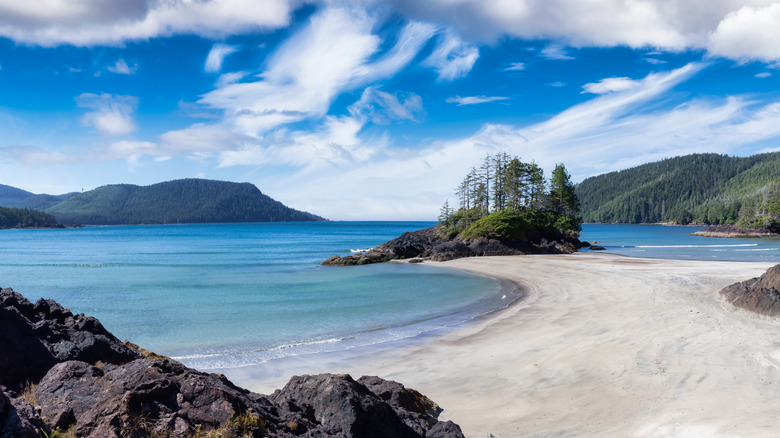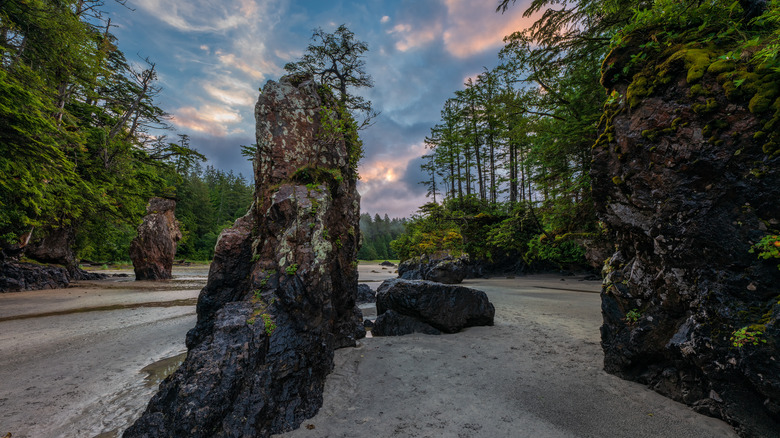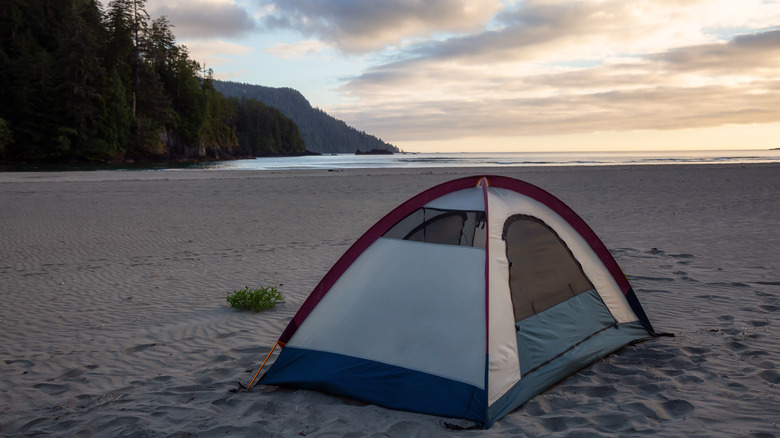Canada's Best Beach Is On An Otherworldly Island Of Rocky Sea Stacks, White Sands, And Untamed Beauty
When planning a beach holiday, most of us promptly picture clear, crystal waters, sun-kissed shores, and a cocktail in hand. But what if — among the best places to stretch your legs on the sand — Canada made the list? Located at the northernmost point of Vancouver Island in British Columbia, San Josef Bay holds the distinction of being one of the top 50 beaches in North America — and the only one in Canada to appear on the list. Nestled in Cape Scott Provincial Park, away from the daily urban chaos, this little-known marvel boasts striking sea stacks, sea caves, and sandy beaches fringed with pines. The place is steeped in wildness and a sense of absence, as if you were living a scene from "Cast Away." Once an uncharted territory, this spot is now known among locals and has grown into a favorite destination for outdoor enthusiasts.
The Indigenous Kwakwaka'wakw people originally inhabited this hidden area, long before the first Danish colonizers arrived between the 18th and 19th centuries. The colonists relied on fishing and farming, but the unpredictable climate made settlement difficult. The area was later abandoned and impacted by forest logging activity, leading to the foundation of Cape Scott Provincial Park.
Despite the possible weekend crowds, this remote location still offers the tranquility and stillness you may seek, with stunning views of the endless ocean. The region is a veritable haven for nature lovers and adventure seekers alike, with other dreamy islands nearby like Vancouver's "Wild West Coast." On the other hand, those visiting the mainland may enjoy the Caribbean-blue waters of British Columbia's Kalamalka Lake.
What to see at San Josef Bay
Split into two by a headland, the beach stretches along the bay and can be crossed on foot when the tide is low, allowing you to explore both sandy sections. The first beach is easier to access and is the one you'll encounter after the hike, while the second one is more secluded. The second beach is accessible during low tide, but it can be reached via another route if the tide is too high — though, the path will be soggy and steep. Rock pools and caves also enhance the landscape, awakening a sense of exploration. The tidal pools are home to small marine animals, such as red sea squirts and moon snails, whereas nearby, you can spot amphibians like toads and salamanders. Boat trips are also available for those hoping to see whales and orcas. For those interested in exploring the local marine life, check out Bamfield, one of Vancouver Island's seaside villages that makes a perfect spot for scuba diving.
San Josef Bay is also considered a notable location for birdwatching, where you can catch sight of bald eagles and ospreys or shorebirds like Western sandpipers. On the ground, don't be surprised if sea otters make an appearance, along with more potentially dangerous animals like wolves and black bears. It's important that visitors take caution while exploring the area by carrying bear spray and storing all food properly.
The bay is best visited in summer, when the tide is low and you can weave your way around the sea stacks. If you happen to explore the area on a cloudy day, you may find the mist gracefully settling on the trees and island pinnacles, adding a touch of mystery to the landscape.
How to reach San Josef Bay and what to bring
Patience is a virtue, as the saying goes — and you'll need plenty of it. Before you get awestruck by the wild beauty of the scenery, an eventful journey awaits. Starting from Port Hardy, approximately 39 miles from Cape Scott Provincial Park, you'll drive for about 1.5 hours, embarking on a 60 km logging road filled with potholes and sharp rocks — which can be especially challenging if the weather conditions are not ideal. En route, you'll encounter street signs wishing you good luck or warning you of the unexpected, as if to ward you off. Don't forget to bring a spare tire — or three — just in case. Upon arrival, you'll come across a parking lot and might ask yourself, "Have we arrived yet?" But the answer is no. At this point, prepare to warm up your legs with a 45-minute hike to San Josef Bay. The trek out to San Josef Bay may sound unappealing to some, but it's totally worth it.
Campgrounds are available for those wanting to spend a couple of days immersed in untamed nature. Basic facilities are available, including bear caches, pit toilets, and a water source at the second campground, but make sure to treat the water before drinking. Wearing proper hiking gear will make your adventure more comfortable. This includes trekking boots, a rain jacket, warm clothes, a first aid kit, insect repellent, and toilet paper — the last of which is always a good idea. Pack your swimsuit, too, to take a dip in the ocean. Campfires are allowed, unless otherwise stated, so you can keep your nights toasty and your food hot. However, check for fire bans before your trip and consider a camp stove as a safer alternative.


